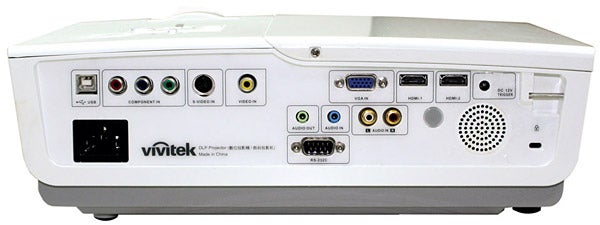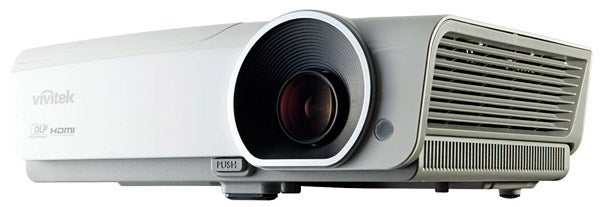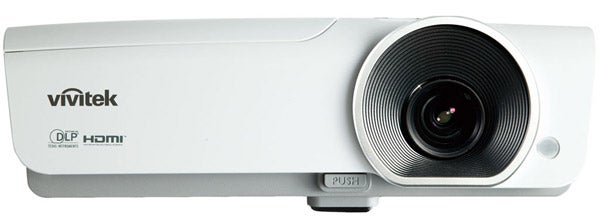Vivitek H1080FD DLP Projector Review
Vivitek H1080FD DLP Projector
The Vivitek H1080FD is a startlingly cheap DLP projector, but can it make it onto your 'must audition' shortlist?

Verdict
Key Specifications
- Review Price: £849.00
Talk about extremes. Back in July we checked out an LED projector – the H109080FD – from new (to the UK) projection brand Vivitek that cost a cool 11 grand. Yet here we are today looking at a Vivitek projector that can be yours for the princely sum of £849. Including VAT.
Most brands don’t have anywhere near this level of price diversity within their range, and the mind frankly boggles about the difference in performance level I might expect to find between the two models. Which is a fancy way of saying that I can’t help but be worried that the entry-level H1080FD will turn out to be as bad as the H9080FD was outstanding…
Not surprisingly, the H1080FD doesn’t deliver nearly as much sheer product volume for your buck as its illustrious flagship sibling. Its 335 x 102 x 256mm dimensions are entirely in line with the sort of coffee table-friendly fare seen with rival ultra-budget models from the likes of InFocus, Optoma and, in the distant past, Panasonic.
The H1080FD is reasonably smartly dressed for such a cheap unit too, with a tidy white finish and tastefully rounded edges. The only thing that looks a bit off aesthetically is its lens. It’s a very small affair – only a bit over an inch across – but it’s been shoved unceremoniously inside a barrel that looks as if it was designed with a much larger lens array in mind, with rather cheapo-looking black plastic ‘screening’ being used to hold the lens in position.
The H1080FD’s connections are outstanding for its money. Two HDMIs get the ball rolling, when I really would only expect one on such an affordable machine. But remarkably the projector also carries a USB port, an RS-232C control port, a D-Sub PC port, and even a 12v trigger output you could use to automatically fire up a motorised screen.
It’s slightly disappointing to find that the USB port is only there for service use, and wouldn’t let me play my digital photos through it. But such disappointment is scarcely unfair when you’re talking about a projector as cheap as the H1080FD.
Turning to the projector’s innards, the first thing to say is that the H1080FD, not surprisingly for its money, has ditched the H9080FD’s LED lighting in favour of a straightforward 0.65in single-chip DLP/230W lamp set-up.
However, impressively for the price, the resolution of this chipset is a native Full HD 1,920 x 1,080. What’s more, the lamp is reckoned to pump out a high maximum of 1,800 Lumens, while the projector’s full on/off contrast ratio is reckoned to be a respectable (for this level of the market) 4,000:1.
The only concern I have with these figures is if the brightness is actually too high, hinting at a PC-biased picture performance rather than something suited to films, which tend to favour strong black level response over brightness.
Setting the H1080FD up is a fairly straightforward process. There are screw-down legs at the projector’s rear and a pop-down leg to the front to help you angle the image correctly onto your screen, while zoom/focus rings are made easily accessible via a hole in the projector’s top side.
Inevitably, though, there are limitations. For starters, the optical zoom on offer isn’t exactly spectacular, with a throw ratio of 1.6-1.92. The lens is designed with short throw distances in mind, too – a reasonably sensible move to some extent, given the casual ‘living room’ use it will probably most be bought for. But it did make the H1080FD the first projector I’ve tested for quite a while that’s required me to get off my backside – outrageous! – and move my projector stand forward from its usual position right at the back of my 5m long testing room. 
The other more irksome set-up shortcoming is the lack of any vertical or horizontal optical image shifting. This means that many people will have to use the projector’s built-in digital keystone adjustment facility to get the sides of their picture looking straight, with all the potential for damaging the picture that any sort of digital tomfoolery always introduces.
Heading into the H1080FD’s surprisingly well-presented onscreen menus (via a decently organised and impressively backlit remote control), I found a respectable number of features to help me calibrate images to suit my tastes. Among the highlights are a colour management system that lets you adjust the hue, saturation and gain for the red, green, blue, cyan, magenta and yellow colour components, a surprisingly flexible gamma adjustment, and a flesh tone tweaker.
The projector thoughtfully provides three memory banks where you can store your own preferred settings, as well as three pre-programmed presets: Movie, Normal and Bright.
It’s a shame, perhaps, that Vivitek couldn’t have added Sports and, especially, Game presets to this list, but it doesn’t take too long to set up suitable presets for these sorts of sources yourself.
If you do get involved with fine-tuning the pictures, though, I’d strongly recommend that you always use the Movie mode as your starting point, since to be honest the Normal and Bright presets are both pretty dodgy. In fact, if you first watch the H1080FD with either of these latter modes selected, the grey wash that hangs over everything, together with some seriously unconvincing colours, are both pretty alarming.
The Movie mode, though, miraculously and instantly makes colours look a whole lot more credible, while also lifting black levels from a disappointment to an actually quite respectable level, at least with movies.
In fact, in Movie mode the infamous knotted rope/dangly bits torture sequence from ”Casino Royale”, with its pitch black background, tricky skin tones and stylised lighting, thus looks far more watchable and convincing than is commonly the case with a projector costing under a grand.
Don’t get me wrong. I’m not talking here about colours enjoying the sort of subtlety of blend and tone that distinguishes decent projectors higher up the price tree – especially where deep greens are concerned. And black levels do still look cloudy enough to hide shadow details, leaving dark scenes looking a little flat. But at the risk of labouring what’s a screamingly obvious point, for its money the H1080FD really doesn’t do a bad job at all with colours or contrast.
Especially as it’s got another very unexpected string to its picture bow: startlingly good fine detailing. HD films look as textured and sharp on the H1080FD as they do on many projectors costing four times as much, with all the picture minutiae that distinguishes HD from its standard definition counterpart displayed with startling confidence. You even get a good sense of the filmic grain so beloved of most Blu-ray authoring houses these days.
It’s worth stressing, too, just how dynamic the H1080FD’s pictures tend to look, as the high brightness output ensures images have plenty of punch without looking nearly as washed out as I would have expected them to. This is particularly true if you use the Boost lamp output mode (something that’s worth at least trying, as it doesn’t screw up black levels as much as similar systems on some rival models).
Inevitably, though, there are signs of the H1080FD’s budget nature beyond the occasional rogue colour tone and crushed black level.
For starters, images – especially very dark ones or shots containing clear blue skies – look a bit noisy at times. Next, ‘mid-bright’ images containing a mix of bright and dark content sometimes look a little muted compared to more universally dark or bright images.
It also seemed to me during very dark scenes that there was some low-level deviance in colour tone in different parts of the image – though this is only noticeable with nearly completely black content.
Elsewhere, I found feeds of ”Halo 3 ODST” from my Xbox 360 not looking as rich in black level as normal video feeds – a situation also recently seen on Samsung’s LED LCD TVs. But the H1080FD doesn’t have the HDMI black level adjustment solution that the Samsung TVs offered.
Another curious discovery is that the H1080FD doesn’t seem happy playing 1080p/24 Blu-ray outputs. The strangeness began when my Pioneer LX91 Blu-ray deck’s HDMI ‘handshake’ with the projector led to a default output of 720p – despite the projector having a Full HD native resolution. Then, when I forced the Blu-ray output into 1080p/24, the projector’s saturation levels and general colours tone kept shifting in a really quite distracting fashion. Still, 1080p/60 worked absolutely fine, so I don’t see the 1080p/24 issue as being a major off-putter for the H1080FD’s casual target audience.
One thing that certainly could be a major issue, though, is something I predicted as soon as I found out that the H1080FD uses DLP technology: the rainbow effect. 
This phenomenon, caused by the single-chip DLP’s colour wheel, finds stripes of pure red, green and blue flitting momentarily into your peripheral vision if you move your eyes over the image. In fact, on the H1080FD the problem is severe enough to be easily visible over very bright parts of the image without you moving your eyes – especially during camera pans. It’s worth stressing here that not everybody sees the rainbow effect. But while I myself am not generally as affected by it as one or two of my friends, I still regularly noticed it on the H1080FD.
A couple of other niggles I have with the H1080FD are a) that it runs a bit more noisily than I’d like it to, especially using the Boost lamp mode, and b) that the vents down the projector’s sides and the rather clumsy lens design both let quite a bit of light escape into your room.
With the H1080FD’s picture assessment complete, I’d normally head off into the Verdict at this point. But in a bid to make itself even more easy to use for the plug and play crowd, it has a built-in 5W mono speaker, so that you can get sound to accompany your pictures without having to rustle up a separate audio system.
Clearly this solution is hardly ideal for movie viewing, partly because of the inevitable lack of raw audio power, but also because the audio is produced at such a distance from the image it’s supposed to be accompanying. In fact, in my room set-up, the projector sits behind my viewing position, so the audio/video dislocation couldn’t be more extreme!
To be fair, though, the quality of audio produced by the speaker really isn’t bad; decent volumes can be obtained, and there’s more clarity in the mix than I’d expect from a mono speaker. So I’d definitely say that the sound is good enough to work with a casual gaming session or sporting event.
”’Verdict”’
Although there are clear signs of the H1080FD’s budget nature in its build quality and some aspects of its performance, it still does plenty well enough to warrant at least an audition if you’re in the market for a startlingly cheap ‘part-time’ projector.

Trusted Score
Score in detail
-
Value 9
-
Features 7
-
Image Quality 7
-
Design 6

